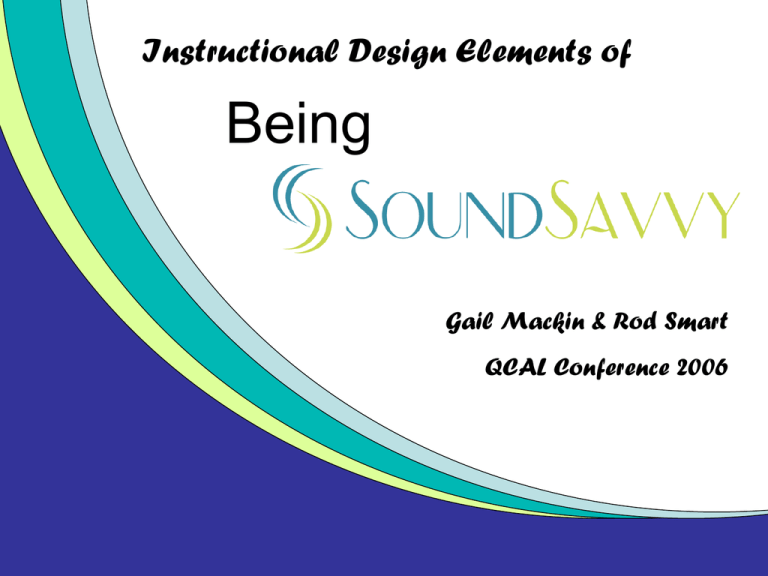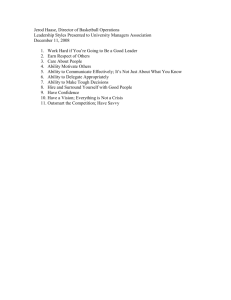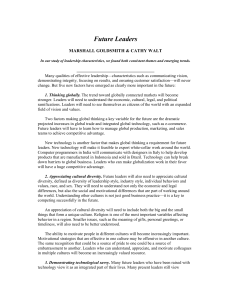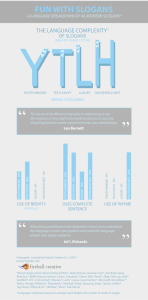abstract processing
advertisement

Instructional Design Elements of Being Being Sound Savvy Gail Mackin & Rod Smart Gail Mackin QCAL Conference 2006 October 2006 Program • Review the Being Sound Savvy DVD • Review different learning theories • Compare Being Sound Savvy DVD instructional design with principles of learning theories • Informal feedback on the DVD Development Process • • • • • • Adult Literacy teacher Self doubt Research Adoption Change – Scope & Sequence Development Research • General searches – Auditory discrimination, phonemic awareness, phonics, whole language, learning theories, novex analysis, adult literacy *, spelling, reading, writing, • Specific searches – http://jan.ucc.nau.edu/~jar/Reading_Wars. html – http://education.independent.co.uk/schools/ article352916.ece – www.literacytrust.org.uk – www.nrrf.org/article_anderson6-18-00.htm Learning Theories • Algo-Heuristic – • Androgogy – L. Landa M. Knowles • Constructivism – J. Bruner (& others) • Experiential Learning – C. Rodgers • Information Processing Theory – • Operant Conditioning – B.F. Skinner • Genetic Epistemology – J. Piaget G. Miller http://tip.psychology.org/theories.html Algo-Heuristic • Concentrates on the cognitive processes that underlie expert thinking & performance – Determining algorithms & heuristics – unambiguous instruction sets – Imparting knowledge (content) & cognitive operations (processes) Being Sound Savvy Presentation of graphemes – single sounds – digraph sounds – modifiers that may or may not have a sound, and – letters that can act as both vowels and consonants Androgogy Emphasizes that adults are • self-directed • expect to take responsibility for their learning • need to know why • need to learn experientially • use problem-solving approach to planning & evaluation • learn best with immediate value Being Sound Savvy self-directed – – – – Direct navigation View any category Choose content Not locked into sequential pathway responsibility for their learning – RESUME button allows for extended breaks need to know why – Created ‘Getting Started’ explanations Being Sound Savvy need to learn experientially – Self directed navigation – – Kept all elements to within 2 mouse clicks Kept Main Menu available at all times – – – Avoid patronising with childish navigation Avoid text driven navigation Made clear a/v explanations use problem-solving approach to planning & evaluation learn best with immediate value Constructivist Theory Learning is an active process in which learners construct ideas based on their own knowledge, therefore instruction should consider… – – – – the learner’s predisposition toward learning the way knowledge is structured the most effective sequencing rewards & punishments for learning Being Sound Savvy Immersion in reading stories – culturally appropriate texts – builds on previous knowledge and experience Comprehension - stages of comprehension – – – – – Recall Analysis Prediction Application Synthesis Experiential Learning Distinguishes between 2 types 1. Cognitive (meaningless) 2. Experiential (significant – addressing needs & wants of learning) Learning is facilitated when… – – – – – Positive climate for learning Purpose of learning is clarified Resources are organised & made available Intellectual and emotional components are balanced Thoughts & feelings can be shared Being Sound Savvy • Assumption for content plan: The learner WANTS to learn • • • • • Not used Ivory Tower approach Considered colour blind people Selected presenter profiles Showed mouth shape for ESL learners Integrated learner interaction Being Sound Savvy • Clarify the purpose of learning – Used iconic navigation to • Set positive climate for learning – Used adult graphics – Specific guidance for each section – Positive feedback • Balance intellectual and emotional climates – Used adult graphics – Choose male/female presenter Information Processing • Concept of “chunking” • Concept of TOTE (Test-Operate-Test-Exit) Being Sound Savvy • Chunking • TOTE – Scope & Sequence – Entry/Exit points built in Operant Conditioning Changes to behaviour (response) are the results of events (stimuli) that occur in the environment Being Sound Savvy Positive feedback • Pick a Sound exercise – – – – Reward for behaviour Immediate Relevant to the word Expressed in positive language In this word, the sound is in the middle. Try again You might be confusing the /b/ and the /d/ sounds. Have another go You’re probably using visual clues. Listen again. Uh, uh! Genetic Epsitemology Cognitive structures, patterns of physical & mental action, underlie intelligence and correspond to stages of child development • Sensorimotor (0-2 yrs) • Preoperations (3-7 yrs) • Concrete operations (8-11 yrs) • Formal operations (12-15 yrs) Being Sound Savvy intuitive knowledge (0-7 yrs) words context sentence structure language interaction logical processing (8-11 yrs) explicit structured sequenced abstract processing (12-15 yrs) NRS 3 & above Indicators of Success Phonemic and Phonological Awareness – 5 levels of phonemic awareness – Adams (1990) – Causal role in reading acquisition – Stanovich (199394) – Prerequisite for, and consequence of, reading – Yopp (1992) Adams, Marilyn Jager (1990). Beginning to Read: Thinking & Learning about Print. Cambridge, MA: Bolt, Beranek, and Newman, Inc ED 317 950 Stanovich, Keith E. (1993-94). “Romance and Reality (Distinguished Educator Series.” Reading Teacher, 47(4), 280-91. EJ 477 302 Yopp, Hallie Kay (1992). “Developing Phonemic Awareness in Young Children.” Reading Teacher, 45(9), 695-703. EJ 442 772 Sound Savvy Program • Develops auditory discrimination and phonemic awareness skills • Develops systematic presentation of graphemes and phonemes • Develops story content into adult themes • Introduces ‘rules of construction’ for words and sentences (spelling & grammar) Sound Savvy Philosophy • Language is a natural process of human development, acquired through immersion in language and relationship • Reading is a coding/decoding skill, acquired through systematic and intensive development of sound-symbol relationship, esp in the early stages of learning • Auditory discrimination and phonemic awareness are underpinning skills required of any reading instruction Sound Savvy Resources • Interactive DVD – for personal or formal, group work • Grapheme Flash Cards • Flipchart Combo Book • Preliminary Readers 1, 2, and 3 • Preliminary Workbooks 1, 2, and 3 • Teacher Reference Book • Phoneme / Grapheme Chart • Diagnostic assessment instrument (for AD/PA) Scope & Sequence • Flash Cards – Consonants – Vowels (short & long) – Digraphs & Diphthongs • Preliminary Readers / Workbooks – With DVD or teacher instruction • Stories – Develop comprehension and critical thinking Being Sound Savvy Thank you for your interest






